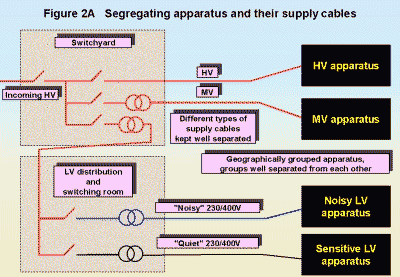
EMC for Systems and Installations: Part 2EMC for Systems and Installations: Part 2 - EMC techniques for installationsBy Eur Ing Keith Armstrong C.Eng MIEE MIEEE
|
This is the second of six bi-monthly articles on EMC techniques for system integrators and installers, which should also be of interest to designers of electronic units and equipment. The material presented in this series is based largely on the new book "EMC for Systems and Installations" [1] which I co-wrote with Tim Williams of Elmac Services. This series will mostly address the practical issues of controlling interference, which would still be commercially necessary even if the EMC Directive did not exist. EMC management, testing, legal issues (e.g. compliance with the EMC Directive), and theoretical background are not covered - although they are in [1]. For more depth, read the list of references at the end. The topics which will be covered in these six articles are:
Remember that safety is always paramount, and should not be compromised by any techniques intended to help achieve EMC. This may require the involvement of competent safety experts in making EMC decisions.
Note that meeting the EMC Directive may not be sufficient EMC work to achieve functional safety, as required by a large number of safety regulations (such as the Machinery Directive). Where malfunction of electronic devices can give rise to functional safety risks (e.g. in all robotics, and some machines and process control) then EMC must be addressed as a safety issue, and merely meeting the EMC Directive and relevant harmonised EMC standards may not be adequate. This topic will not be covered explicitly in this series of articles, but it is hoped that the Journal will be able to report before too long on the publication of an IEE Professional Guidance document on EMC and Functional Safety. Table of contents for Part 2
This paper should be treated as merely a guide to some of the modern EMC techniques for use inside installations such as buildings. It does not cover the assessment of the electromagnetic environments; specification, design, assembly, or proving of equipment; filtering; shielding; lightning protection or surge suppression; all of which play their part in ensuring that a lack of EMC does not cause problems in the operation and compliance of an installation. External services and communications are not covered here.
A large part of this Part 2 is taken from reference [3].
2.2 Segregation of apparatus and their supplies
An installation's apparatus and their supplies should be arranged in geographically separated groups right from the start of a project. This is easy to do very early on, and can save enormous amounts of time and cost later. Apparatus should be classified as high-voltage (HV, > 33kVAC rms), medium voltage (MV, between 1 and 33kVAC rms) and low voltage (LV, < 1kVAC rms). Low voltage equipment should then be classified at least as 'noisy' or 'sensitive', with more sub-categories used where even greater control of EMC is required.
Examples of noisy equipment include adjustable-speed motor drives; metal or plastics electric welding; power rectifier systems for electrochemical processes; radio, television, and radar transmitters; and power conversion. Examples of sensitive equipment include radio, television, and radar receivers, instrumentation for temperature, flow, weight, pH, humidity, pressure, etc.; cathode ray tube (CRT) visual displays; induction loop audio systems, and programmable electronic systems such as computers and PLCs.
Figure 2A shows an example of such segregation.

The different classifications of apparatus and their power and signal cables should be powered via different distribution networks which run separately from each other, and the two (or more) classifications of low voltage equipment should ideally be powered from different distribution transformers. The different classifications of apparatus should be spaced well apart from each other (metres rather than centimetres), and any other cables associated with each type should be routed well away from each other.
Where equipment cabinets contain both noisy and sensitive equipment, their manufacturers would be expected to achieve internal segregation so that one did not interfere with the other. For example, if a fork-lift truck battery charging station and a computer or fileserver room were adjacent to each other it is possible that the battery charging could interfere with any CRT displays and/or the operation of the computer system. At the initial design stage it is easy to allocate these facilities to well-separated locations, and costs nothing to do. If interference problems are discovered during commissioning (or afterwards) the very significant costs of moving one of the facilities and its cabling well away from the other are likely to be dwarfed by the lost production due to the delays incurred.
Similar problems can arise in the food industry, where (sensitive) checkweighers and metal detectors are followed closely by packaging machines employing (noisy) radio-frequency (RF) plastic welding techniques for sealing plastic bags or cartons. If not designed-in from the beginning, the distance required between the packaging machine and the other equipment may not be achievable without wholesale re-structuring of the production line, at great cost.
2.3 Routing Send and Return current paths together
All the current send and return paths associated with any load should be routed together as closely as is possible. Twisted pairs, triples, quads, etc., are best. Busbars are best spaced apart by thin layers of solid dielectric. Very heavy individual cables should at least be run as close together as they can be (taking full account of other physical limitations).
Figure 2B shows preferred and non-preferred routes where one of the conductors is switched, for example by manual switches in a room lighting circuit, or by relays or contactors in a control panel.

This technique reduces both differential and common-mode the couplings of magnetic and electric fields between the cable and its electromagnetic environment (see Part 1). Although Figure 2B shows a power application this technique is vitally important, for both emissions and immunity reasons, whatever electrical signals or power a cable may be carrying, from weak transducer signals, through high-speed data, to heavy power.
Screening cables for EMC is of little use unless both send and return conductors are enclosed together in a single screen. The better the physical balance between the send and return current paths, and the better the electrical balance between the signals they carry, the better will be the electromagnetic performance of the cable (whether it is screened or not). Transducer signals would suffer terribly from interference in many modern systems if it were not for the intelligent use of screened twisted-pair cables, where the twisted-pair (but not the screen) carries the transducer's + and - signals.
Power cables also benefit from close proximity of send and return conductors. For a delta connected three-phases system this would just involve the three phases, but in a star-connected system it would involve all three phases plus their neutral. Very heavy power cables, such as those feeding the main DC motors in a steel rolling mill, could suffer high mechanical stresses on their conductors if placed too close together (from the electro-motive forces created by the interactions of their magnetic fields) and this could damage their insulation. Air-insulated high-voltage cables also have to be separated by considerable distances to prevent discharges between the conductors.
In both of the above cases, or whenever power send and return conductors do not follow virtually identical paths in close proximity, it must be accepted that high levels of electric and magnetic fields will occur in their vicinity, and may upset the operation of nearby electronics. For example, problems with image stability on CRT type VDUs are often caused by the magnetic fields from nearby power cables where the send and return conductors are widely separated.
A problem with this technique can occur for cables carrying very heavy currents. The electro-motive forces on the cables due to their powerful magnetic fields can subject their conductors to very high mechanical forces, and can cause the insulation to wear out too quickly. Where power conductors have to be separated for this reason, it will be very important indeed to keep these cables segregated well away from any sensitive electronics. Where such powerful magnetic fields exist (and they are easily calculated) they should also be checked against personnel exposure limits to protect staff and third parties from health hazards.
2.4 Meshed bonding ('earthing') networks
2.4.1 Why star bonding is not good practise in general
Long ago, most of the interference problems in installations were at 50Hz and it was possible to control circulating currents ('earth loops') using star bonding techniques. These days the environment is highly polluted with frequencies up to thousands of MHz, and getting more so by the day. At the same time the signals used by electronic communications now regularly extend to 30 MHz and above. At the frequencies in typical use these days the stray couplings due to mutual inductances and capacitances creates circulating currents that flow through air or insulation for at least part of their paths. These cannot be effectively controlled by star bonding. For more on stray coupling, see Part 1 of this series.
Now that we cannot (in general) use star 'earth' bonding, we need to embrace its opposite: mesh bonding. (The half-way house of partially-meshed bonding generally has the problems of both and the benefits of neither.) Mesh bonding has its drawbacks, but they are capable of being dealt with, whereas the drawbacks of star bonding for modern environments and technologies can't be dealt with in any practical way.
2.4.2 The MESH-CBN
Figure 2C shows the recommended common bonding scheme for a fixed installation, often called mesh earthing. This achieves a low impedance from 50Hz up to higher frequencies (depending on average mesh size), and is an important element of modern installations with their concentrations of high-technology equipment including computers and telecommunications.

[4] - [10] use the acronym CBN for the common bonding network that is often colloquially referred to as the earthing structure, and they refer to a 3-dimensionally meshed CBN as a MESH-CBN. This is the terminology I shall use throughout the rest of this Part.
Heavy current equipment requires a closer mesh to prevent high voltage drops in the case of leakage or fault currents. High-frequency equipment (such as computer or telecomm's equipment) also requires a smaller mesh size to prevent voltage drops due to earth inductance. Sensitive instrumentation often requires a smaller mesh size because it is vulnerable to voltage differences in the CBN over a wide range of frequencies.
Figure 2D shows a different perspective on the modern concept of the MESH-CBN, showing how it is connected to the lightning protection system (LPS) and its system of earth electrodes.
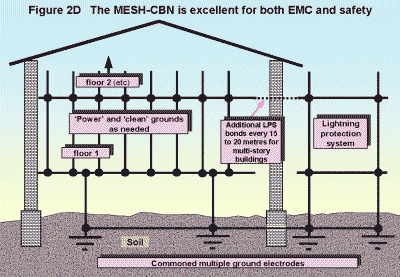
Meshing the CBN helps protect equipment against the damaging effects of lightning surges, and surge protection devices (SPDs) function better when they are connected to a low-impedance CBN. For lightning protection (where most of the energy occurs at frequencies below 10kHz), it is generally recommended that no part of a site should have a CBN whose mesh size exceeds 3 or 4 metres, in any dimension.
It is recommended to use so-called natural metalwork, such as re-bars, girders, structural metalwork, and any other metalwork to help achieve a MESH-CBN, as shown in Figure 2E.
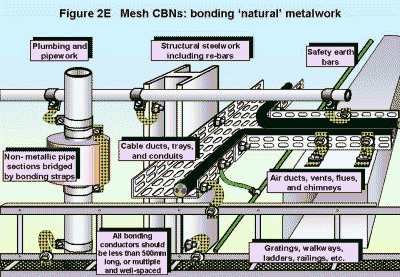
Bonding should ideally be metal-to-metal, and seam welding is best. Short conductors may be used instead with a reduction in high-frequency performance, as shown by Figures 2F and 2G.
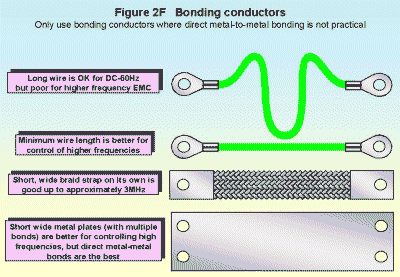
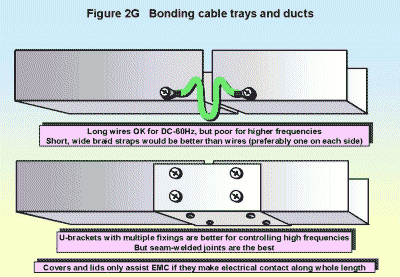
Where high-integrity systems are required to continue functioning despite environmental extremes (especially nuclear and military control rooms) the mesh size of the CBN may need to be reduced so far that metal floors or walls, or even seam-welded metal rooms, become practical options.
2.4.3 The bonding ring conductor
It is recommended that the MESH-CBN at each level of a structure incorporates a bonding ring conductor (BRC) with a substantial cross sectional area (CSA), at least capable of handling the maximum fault currents. Incoming cables and metallic services such as air, gas and water pipes, ventilation ducts, etc. should be bonded to a single main earthing terminal, which itself forms part of the BRC and is connected to it at each end. Where direct bonding is not practical, for example signal and power lines, they may need to be surge protected and/or filtered at the same physical location as the mains earthing terminal. Sometimes the main earthing terminal may need to be a large plate, to allow filters to be properly bonded (see Part 4). Figure 2H shows an example of a BRC for one floor of a building.

The general idea, which Figure 2H tries to show, is that the BRC travels around the perimeter of the area concerned, at least the floor of each building or each level of a structure, and is connected by single short bonding conductor to each item of apparatus (and the power conductors this should always be routed physically very close to this bonding conductor). Where an item of apparatus has to be some distance from the BRC, two or more bonding conductors should be used, widely separated from each other, to attempt to reduce the inductance of the connection to the BRC. A lot more detail on the construction of BRCs will be found in [4] to [9].
Sometimes it is necessary to segregate an area within a floor or level to better control especially noisy or sensitive apparatus (e.g. an area of computers or instrumentation), as shown in Figure 2H. Such a segregated area is sometimes called a zone, especially in IEC lightning protection standards. The zone will have its own main earthing terminal, where all incoming cables and services are bonded, surge protected, and/or filtered. Such zones will also often have a smaller mesh size for its CBN, and may even require a 'bonding mat' as described later.
Where it is necessary (often when upgrading older installations) for a cable or metallic service to enter a floor or a zone remotely from its main earthing terminal, it should be bonded (or surge protected and/or filtered) instead to the BRC as it crosses it. But it should be recognised that this is not an ideal situation and the cable or service may need to be re-routed if problems arise.
2.4.4 Bonding mats
Because of the high frequencies now in common use in Information Technology (IT) and Telecommunication rooms, control of the local reference potential over the area occupied by an IT or telecomm system is becoming very important. I understand that some internet server manufacturers are now specifying a maximum ground potential difference of no more than 15mV at any frequency of concern over the area occupied by their interconnected computers - a difficult specification to meet. Where the environment suffers from high levels of high frequency disturbances, control of the local reference potential plane may be important for the correct operation of low-frequency electronics, such as instrumentation or audio systems.
Bonding mats (sometimes called system reference potential planes, or SRPPs) are the name often given to ways of improving local reference potentials, although they aren't soft to the feet or made of fabric so aren't really mats at all. Figure 2J sketches a common type of construction.
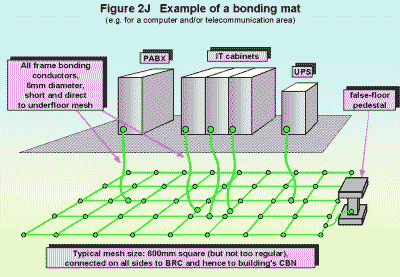
Typically these bonding 'mats' use a mesh of copper wire or lighting tape on a 600mm grid, installed beneath the computer flooring and bonded to the equipment cabinet frames by 6mm CSA cable no longer than 500mm. It is sometimes possible to use the metal support structure for the computer flooring, or metal-covered computer flooring tiles, as a bonding mat. Each bonding mat requires a BRC around its perimeter.
Figure 2K shows how the MESH-CBN for a multi-level IT or telecomm building might be designed. Each floor has its BRC and its bonding mat, and they are all interconnected with the rest of the building's MESH-CBN both horizontally and vertically, using 'natural' metalwork where possible (such as re-bars) but adding metalwork or bonding conductors where the mesh is too large.
 Although each application will differ, a 600mm meshed bonding mat as sketched in Figure 2K ought to be able to achieve the old IBM specification of ground potential differences of no more than 1V over a computer installation. But where better control and/or higher frequencies are required (e.g. where the specification is 15mV and communications use frequencies of up to 30MHz, typical of 100MHz and GHz Ethernets) the grid size may need to be much smaller - a metal sheet is best - and the frame bonds may need to be much shorter. It is not unrealistic in some applications to install a seam-bonded metal floor, stand the equipment cabinets directly on the metal floor, and bond them to the floor with very short straps, maybe even one at each corner or one every 300mm or so of cabinet perimeter.
Although each application will differ, a 600mm meshed bonding mat as sketched in Figure 2K ought to be able to achieve the old IBM specification of ground potential differences of no more than 1V over a computer installation. But where better control and/or higher frequencies are required (e.g. where the specification is 15mV and communications use frequencies of up to 30MHz, typical of 100MHz and GHz Ethernets) the grid size may need to be much smaller - a metal sheet is best - and the frame bonds may need to be much shorter. It is not unrealistic in some applications to install a seam-bonded metal floor, stand the equipment cabinets directly on the metal floor, and bond them to the floor with very short straps, maybe even one at each corner or one every 300mm or so of cabinet perimeter.
NAVAIR AD 115 [11] has some good graphs of the effectiveness of braid bonding straps with frequency, and shows that a single 9" inch long braid strap is useless (or even counter-productive) at bonding equipment to a metal plane above 10MHz. A single 2 inch long strap is required to provide any reliable mat bonding at frequencies of 30MHz. The use of multiple straps, widely separated from each other, allows longer straps to provide effective bonding to the mat at 30MHz. However, bonding cable screens at both ends, and bonding cable trays and ducts to equipment cabinets at both ends (both discussed later in this Part), also helps to improve the local reference potentials by providing lots of parallel bonding paths.
2.4.5 Insulated bonding networks
Older buildings often do not have a good MESH-CBN, and it can be too expensive to create one when only a minor modification or refurbishment is required. Some authorities and standards suggest the use of an insulated meshed bonding network (MESH-IBN) for the IT and telecomm and other new electronic additions to such buildings.
MESH-IBNs should have at least 10kV of isolation from the rest of the buildings bonding network. They have their own BRC and call their main earthing terminal their 'single point of connection' (SPC) to the rest of building or structure. All cables and metallic services are bonded at the SPC (or surge protected and/or filtered), but in this case no exceptions are allowed and no cables or metallic services may enter at other points. The idea is to prevent the uncontrolled currents in the bonding network of the rest of the building from entering the 'clean area' created by the new MESH-IBN.
Although MESH-IBNs can work very well indeed when first installed, they must be designed taking into account lightning and surge protection for personnel. It must be impossible by design, for safety reasons, for anyone to be able to bridge between any equipment bonded to the MESH-IBN and any other equipment or structure connected to a different 'earth'. Consequently, MESH-IBNs are very vulnerable to 'craftsmen', who may, for example, remove a partition or convert a wide walkway into a smaller one and add a row of terminals.
MESH-IBNs are also very vulnerable to technicians and engineers, who may decide to run a copper data or power cable between two areas or rooms, or even between floors, not realising that they are compromising the isolation of the new area. Such additional cables can cause serious risks of electric shock and/or fire.
So perhaps MESH-IBNs are best avoided, unless you can be certain that 100% control of the electrical installation is applied by people who fully understand the concept and requirements of the MESH-IBN, over the entire life of the building.
2.5 Cable screen bonding at both ends
Modern electronic technologies use such high frequencies that cable screens should generally be 360o bonded (i.e. electrically bonded around their entire periphery) to their local EMC-earth at both ends. For high-speed or sensitive signals, the local EMC-earth will generally be the shielded enclosures of the associated electronic units.
Excessive currents in cable screens caused by potential differences between the earths at each end are reduced to negligible amounts by running all cables along parallel earth conductors (PECs) which have a much lower resistance (a much higher CSA) than the cables' screens.
Earth potential differences arise in a number of ways, but all are reduced if the impedance of the earth structure is reduced, which is one of the reasons why meshed earth-bonding networks, as described above, are generally recommended for modern installations.
Power currents (usually 50Hz) flowing in earth structures give rise to potential differences, leading to 'hum' in instrumentation and audio systems. Surges due to nearby lightning activity and high-power transient events (such as switching a large load, or earth-faults in cables and equipment) give rise to momentary voltage differences between parts of the earth structure. Because all these involve relatively low frequencies, the currents involved will divide up generally according to the various path resistances they are offered, so the provision of low-resistance PECs ensures that the earth-potential currents in cable screens which are bonded at both ends is reduced to acceptable amounts (although it is never eliminated).
Screened cables are capable of much greater EMC shielding performance than is traditionally achieved by screen-bonding at one end only. 360o bonding is required at both ends to correctly terminate cable screens and maximise their EMC performance, and this may be achieved by using shielded connectors or 'EMC' cable glands. Saddleclamps, P-clips, and the like, may be acceptable alternatives in situations where the frequencies concerned are low or the EMC performance required not very high. Part 3 has more on this topic.
'Pigtails' (where a length of wire is used to bond a screen to earth) do not allow screened cables to shield correctly. Tests have shown that even a 25mm pigtail can ruin cable screening even at the low frequency (these days) of 70MHz.
Cables should remain close to their PECs at all times, to minimise circulating currents caused by power magnetic fields. For very long cable runs or very polluted EM environments (e.g. where powerful radio transmitters or sources of broadband interference such as electric railway marshalling yards are nearby), it may be necessary to expose cable screens and armour every ten metres or so and bond them to their PEC.
2.5.1 Why earthing cable screens at one end is not good practise in general
Where a good quality MESH-CBN (as described above) does not exist, as has often been the case in the past, it has been traditional to connect cable screens at one end to prevent 'hum loop' problems due to the potential differences of different parts of the earth structure.
This technique is no longer effective, except in special circumstances, because of the poor EMC performance achieved from the screened cables, increasingly incompatible with the high frequencies and sensitivity of modern electronics.
What was often overlooked when the screens of long cables were connected at one end only is that during earth-faults and lightning surges, the whole surge potential can become concentrated at the end with the unterminated screen. This can cause flashover, with consequent fire hazards, but is much more likely to cause actual damage to electronics and expose operators and maintenance personnel to electric shock hazards.
From the point of view of earth-faults and lightning, bonding the screens of long cables at one end only, to prevent 'hum loop' problems, was generally incorrect unless surge protection measures were also taken to limit surge voltages at the unearthed end to safe levels. (Ethernet, for instance, is designed to have only one end of its cable screen earthed, but where dangerous surge voltages can arise the installer should fit surge protection devices to limit them to safe levels.)
2.5.2 What can be done where earth structures are poor?
Where a good quality equipotential MESH-CBN is not available (a common situation when retrofitting in older buildings), it may be possible to run all cables over newly-installed PECs, with substantial CSAs capable of handling the (possibly high) fault currents. To function as PECs, these should of course be electrically bonded at every joint and to the local CBN at both ends (usually an equipment cabinet wall or motor frame).
Alternatively, surge protection and/or filtering measures may be able to be employed, but great care should be taken to meet the relevant installation safety standards (understanding that there is a lot more to surge protection or filtering than merely wiring-in devices).
Possibly the best method to employ where earth structures are poor and it is not desired to install a lot of PECs is to achieve complete galvanic isolation to 20kV or more through the use of fibre-optics (use types with metal-free cables), infra-red, or wireless communications for all signals and data, making sure that their transmitters and receivers have adequate EMC performance for the application.
2.5.3 When manufacturers' instructions require cable screen bonding at one end
Cable screen bonding at one end only may be acceptable for EMC where an equipment manufacturer's electronic unit is connected using low-frequency signals which have been adequately filtered. Unfortunately, it is sometimes not appreciated how vulnerable ordinary analogue instrumentation circuits are to suffering severe errors when exposed to frequencies of hundreds of MHz, and so some instrumentation lacks the filtering it needs to be able to use screen-bonding at one end without suffering EMC problems.
An installation method that may be useful in situations where bonding cables at both ends is necessary for EMC reasons but contradicts a manufacturer's installation instructions, is to use a double-insulated-screen cable, bonding the outer screen at both ends and connecting the inner screen according to the manufacturer's instructions.
2.5.4 When safety standards prohibit these EMC techniques
Some safety standards or codes of practice for explosive atmospheres and the like are understood to prohibit mesh bonding, or the bonding of cable screens at both ends. Clearly, the safety standards must be followed, and where this means that achieving adequate EMC is likely to be made more difficult as a result (especially likely where modern electronic technologies are also employed) then this is unavoidable.
Achieving galvanic isolation for all data and signals using infra-red or metal-free fibre-optics is often a good technique to use in such situations. Projects of this type may also need to use other EMC techniques not discussed here.
2.6 Types of PECs
Figures 2L, M, N, and P show some alternative types of PECs, using heavy gauge wires, strips, trays, ducts, conduit, structural metalwork; and how best to run cables along them.
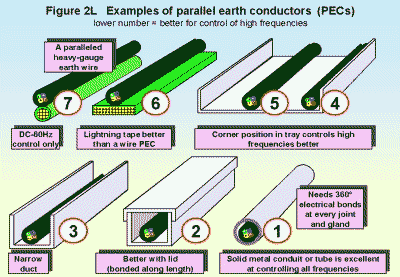
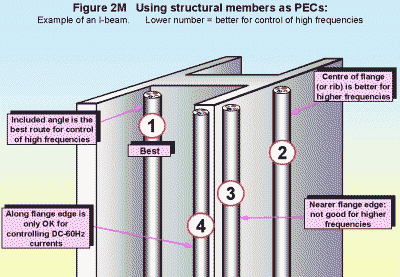
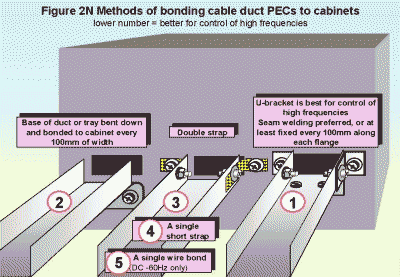

Any part of a properly constructed MESH-CBN may be used as a PEC, and it is best to run a cable over the same type of PEC along its whole length. Of course, PECs must be bonded at each end to the equipment cabinets that the cables enter. They must also be effectively bonded at all joints all along their lengths.
Cables should not "fly through the air" unless they at least have a sturdy wire PEC strapped to them.
For safety reasons PECs should be capable of handling the highest fault currents they may be exposed to. In a well-meshed common bonding network these currents will be smaller than in a sparsely meshed system or star-earthed system, because there will always be a multiplicity of paths for the fault current to take.
Some types of PEC will provide a lower impedance (hence better performance) at higher frequencies than others, as these sketches try to show.
2.7 Bonding cable armour
Cable armour should always be bonded at both ends, and acts as a PEC. Some types of cable armour provide a useful degree of shielding at low frequencies, and where a cable only requires protection against low frequencies it may be acceptable to bond its armour at both ends but its screen at one end only.
2.8 Cable classes, their segregation distances, and cable routing
Low voltage cables (< 1kVAC rms) are split into at least four classes, and each class run along a different route, only bundled with (or in close proximity to) cables from its own class. Cable classes would ideally not cross over each other, but where they must cross, they should do so at right angles (and even then some additional metal shielding may be required between classes more than one class apart).
2.8.1 Cable classes
Here is an example of a classification system based on four classes of low-voltage cables. BS IEC 61000-5-2:1997 describes a system with 5 classes, where the 3rd class is called "EMC indifferent". Since I find it hard to imagine any cables that are truly indifferent to EMC, I have eliminated this indifferent class, but its ghost is still evident in the segregation distances proposed later in this section.
Class 1 is for cables carrying very sensitive signals. Low-level analogue signals such as millivolt output transducers and radio receiver antennae are in Class 1A. High-rate digital communications such as Ethernet are in Class 1B. Classes 1A and 1B should not be bundled together, although their bundles may be run adjacent to each other.
All class 1 cables should use fully screened cables and connectors over their entire path, with 360o screening maintained throughout, from end-to-end. Unscreened twisted-pairs are commonly used for Ethernets and similar data cables, but they are generally not as good for achieving the full data rate or EMC as screened twisted pairs of otherwise identical specification.
Class 2 is for cables carrying slightly sensitive signals, such as ordinary analogue (e.g. 4-20mA, 0-10V, and signals under 1MHz), low-rate digital communications (e.g. RS422, RS485), and digital (i.e. on/off) inputs and outputs (e.g. limit switches, encoders, control signals).
Class 3 is for cables carrying slightly interfering signals, such as low voltage AC distribution (< 1kV) or DC power (e.g. 48V telecomm's power), where these do not also power 'noisy' apparatus. Power distribution that also feeds noisy equipment may be converted from class 4 to class 3 by the correct application of filtering (not a trivial exercise).
Class 3 also embraces control circuits with resistive and inductive loads, where the inductive loads are suppressed at the load (e.g. the electrical coils of relays, contactors, solenoids, actuators, valves, etc.); DOL motors; so-called 'sparkless' DC motors; and the motor cables from inverter drives which have been correctly fitted with 'sinusoidal output filters' according to the manufacturers' detailed instructions.
Class 4 is reserved for cables carrying strongly interfering signals. This includes all the power inputs or outputs (to or from) adjustable speed motor drives; power converters; and their DC links. Class 4 also applies to the cables associated with electrical welders; RF equipment (e.g. plastic welders, wood gluers, diathermic apparatus, microwave dryers and ovens); DC motors or sliprings; and similar "noisy" apparatus., Cables to RF transmitting antennae and unsuppressed inductive loads are also Class 4. All class 4 cables should use screened cables and connectors where possible.
Classes 5 and 6 are reserved for MV and HV supply distribution cables respectively. Air-insulated high-power busbars and high-voltage distribution cannot be screened themselves, so other cable classes in proximity to these may need to be protected by additional shielding or very much greater spacing. Armouring should also be used as a screen, but its effective use demands reliable 360ø electrical bonding methods at all joints and terminations, and even so armour does not generally provide a very good screen for high frequencies (although there are some types of armour which are specifically designed to do so).
2.8.2 Segregation distances
Figure 2Q shows the recommended minimum spacings between cable classes, based on a 30 metre run of cables held close to a common PEC. Longer parallel runs should use pro-rata greater spacings. Cables should ideally be kept within 25mm of a PEC, and this is more important for especially sensitive or noisy cables. The ghostly remnant of the "indifferent" cable class used in BS IEC 6100-5-2 exists as the 300mm spacing between the classes 2 and 3 used here. If the indifferent class was used it would be in the centre of this region, with 150mm spacings either side to classes 2 and 3.
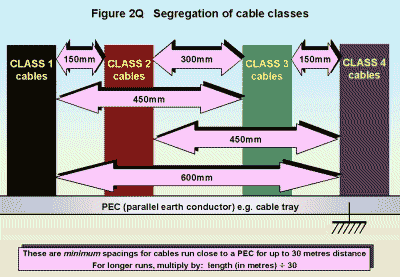
Class 5 cables are not shown in this figure, but should have at least 150mm spacing from Class 4, with Class 6 at least a further 150mm away. Where an MV or HV cable is within 1 metre of a Class 1 cable, the Class 1 cable should be run in a covered metal duct.
It should be pointed out that there is very little evidence for the cable spacings recommended here. However, we can say with confidence that greater spacings generally give lower coupling (crosstalk) between cables, but the acceptable amounts of coupling will always depend on the types of cables, the installation techniques used, the electronics connected to each end of the cables, and the functional requirements of the application.
Internal corner runs in a PEC have lower inductance and are also better at controlling higher-frequency EMC, so should be reserved for especially sensitive or noisy cables. Cable spacings may be able to be reduced if metal dividers are used between classes, or when additional cable screens are used throughout (and bonded to EMC-earth at both ends).
Running individual cable classes in their own closed metal duct or round conduit PECs allows the spacing between classes to be reduced (even to zero), but it is still best to avoid running classes 1 and 4 close together.
Figure 2R shows how cable classes may be split between two (or more) vertically-stacked trays. The vertical spacing between cable classes in such open trays should be the same as the horizontal spacing proposed above.

2.8.3 Cable routing
Cables of all classes should follow the same route between items of equipment, as indicated by Figure 2S, to minimise the circulating currents caused by power magnetic fields.

The cable route shown between the different items of equipment in this sketch may be visualised as the stacked cable trays sketched above (for example). Although the cables follow the same route over their common or individual PECs, they should maintain their segregation by class.
This requirement implies a single connection panel for each cabinet (with the connectors and glands segregated so as to permit cable segregation by class). Cables that enter or leave a cabinet on different sides, or top and bottom, are not recommended.
The effects of circulating currents can be reduced by increasing the CSA of the PECs used (and, for higher frequencies, reducing the RF impedance of the PECs as described earlier). But intelligent cable routing that does not create loops helps reduce the need to use such brute-force techniques.
Figure 2T shows overview details of connecting two shielded cabinets together. However, even ordinary metal cabinets with no specially-designed shielding properties will generally achieve better EMC performance when installed as shown here.
2.9 Interconnecting shielded cabinets
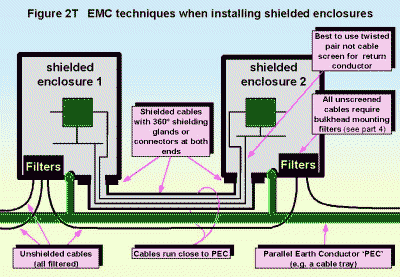
Screened cables should only enter a shielded cabinet through screen-bonding connectors or glands set in the cabinet wall (requiring screen bonding at both ends), and all unscreened cables should only enter through bulkhead mounted filters (or equivalent). All cables between the two cabinets are segregated by class and run in intimate proximity with a PEC that is bonded to both cabinets. This could be a metal cable duct or tray, as described above.
Notice that the electronic units connected together via the screened cable do not use the shield of their screened cable as their current return, instead they use a dedicated conductor. Co-axial cables carry both their shielding and signal return currents in the same conductor (their screen), which can lead to difficulties due to inadequate isolation between the two. Screened twisted-pairs, or twin-ax, or tri-ax, or similar types of cables with internal conductors for signal and return currents and a screen dedicated to carrying only interference currents, are generally preferred to co-axial cable, except where specified by equipment manufacturers in their detailed EMC installation instructions.
2.10 References and further reading
 © Nutwood UK Ltd 2001 |
Eddystone Court - De Lank Lane St Breward - BODMIN - PL30 4NQ Tel: +44 (0)1208 851530 - Fax: +44 (0)1208 850871 nutwooduk@nutwood.eu.com |
|
|
|